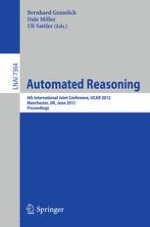This book constitutes the refereed proceedings of the 6th International Joint Conference on Automated Reasoning, IJCAR 2012, held in Manchester, UK, in June 2012. IJCAR 2012 is a merger of leading events in automated reasoning, namely CADE (International Conference on Automated Deduction), FroCoS (International Symposium on Frontiers of Combining Systems), FTP (International Workshop on First-Order Theorem Proving), and TABLEAUX (International Conference on Automated Reasoning with Analytic Tableaux and Related Methods). The 32 revised full research papers and 9 system descriptions presented together with 3 invited talks were carefully reviewed and selected from 116 submissions. The papers address all aspects of automated reasoning, including foundations, implementations, and applications.
